#Glen Vilppu
Note
can you pleaaaase do a tut on how to do torsos on 3/4 angles every time i try to do i end up frustrated and every other construction method turns out wrong
Let’s talk about torsos! Of course, my first piece of advice is to study study study. Try searching for anatomy books at your library, or in an online database. I highly recommend getting some PDF files or actual print of these books to have on hand when you draw. Here are some recommendations:
George Bridgman’s Constructive Anatomy
Michael Hampton’s Figure Drawing Design and Invention
Glen Vilppu’s Basic Drawing Manual
“Anatomy for Sculptors” by Uldis Zarins with Sandis Kondrats

(Source: Michael Hampton “Figure Drawing Design and Invention”)
Now I really like the box method, because a straight line is way easier to draw than a curved line (imo). However, all of these methods are pretty valid.
Try to do a turnaround of your basic figure, keeping the proportions in line. Building on top of the basics is the easiest way to construct a figure:
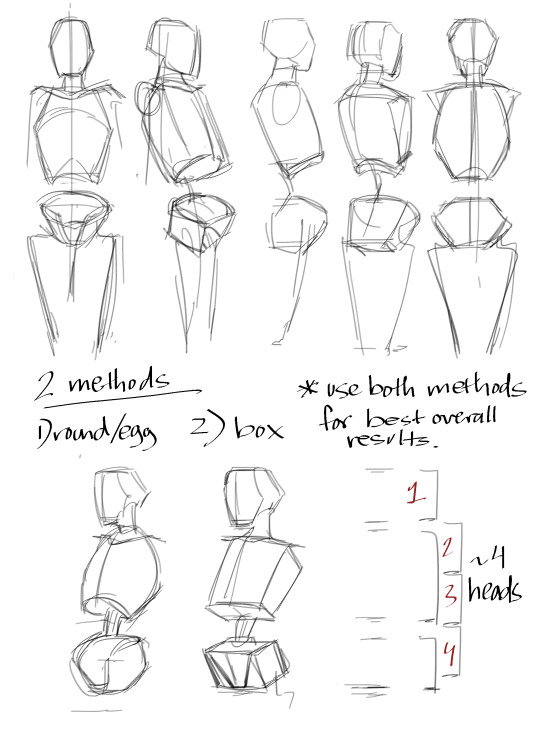
Other than that, my advice is to - you guessed it - practice. My figures now look better than those a year ago, and yours will too. Keep at it, and you’ll grow in skill and consistency.
-Mod Future (ko-fi)
#Anonymous#tutorial#torsos#human anatomy#three fourths view#proportion#anatomy#mod future#theredlinestation
642 notes
·
View notes
Photo
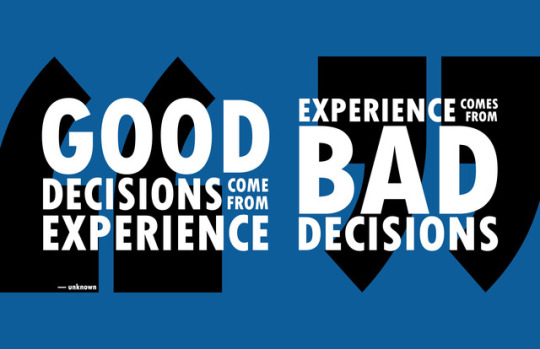
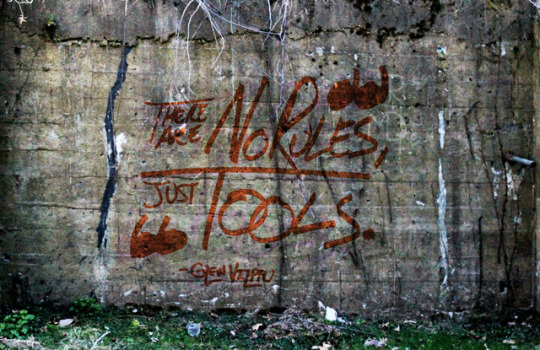
Quote project from my Typography class this semester. We had to have one in an environment and another digitally made with a handmade element in either. My handmade element is my handwriting in the environment one.I tried to go for a graffiti look to match my photo.
Twitter | Art Blog | Instagram | REDBUBBLE
0 notes
Text
How to Improve Artistically
Feel like your art is stagnating? Want to make some progress, or learn some new skills? This is a list of my favorite techniques for breaking out of that slump.
Start every day with a warmup! Draw from imagination, draw from reference, but spend twenty minutes warming your hands up before you go into your big project of the day!
Want to improve your environments? Want to get better at drawing backgrounds? Practice drawing from life- dedicate 15 minutes a day to drawing the environment around you, even if you think it's boring. Go outside, sketch nature, stay inside, sketch sofas.
If you want to practice observational & technical skills,set up still lives. Arrange a variety of objects-soft plushies,transparent glass bottles,reflective mirrors,seashells, and practice drawing (or painting) those! This will help you improve how you render form and substance.
Practice drawing from reference! This gives your mind a wider of vocabulary of structures, inspiration, and information to draw from when you're sketching! Practice drawing animals, practice drawing cars, buildings, bikes!
A big one that I think many artists neglect/forget: Practice figure and gesture drawing. Visit SenshiStock (they have a pose timer now), QuickPoses (NSFW), and CroquisCafe (NSFW) for static and moving figure references! Practice both short gestures, and longer poses!
I recommend spending twenty minutes a day doing figure studies. It can be as your warm up or as your cool down, but even if it feels like wasted time, it's an investment. You're adding poses to your vocabulary, practicing proportion, and honing muscle memory.
Do style/master studies. And it doesn't have to be the old masters, and it doesn't have to be Renaissance painting studies. Do style studies inspired by your favorite mangaka, your favorite animators, from your favorite movies. Figure out (don't just copy) what makes them tick!
Study the fundamentals. Revisiting fundamentals in a guided way can really help polish your skills. If you're self taught (school of internet), I highly recommend Proko, Schoolism, Andrew Loomis, Glen Vilppu, the FAC and the FACC as starting points! Treat it like a workbook- take notes and copy the exercises, then replicate those exercises using your imagination or reference. Rinse and repeat until the ideas are firmly in your head and become second nature.
Drawing regularly can help you improve, because it maintains muscle memory. If you find it hard to draw regularly, consider participating in a monthlong challenge, particularly one with a prompt list like Mermay, Inktober, or Huevember.
A lot of artists want the art school experience, but can't afford the hefty pricetag. The Improvement Hell challenge is the closest guided challenge I've found to a real intensive grad school art experience.
Keep a sketchbook or start an artblog to track your progress. You don't have to share this with anyone, but it's helpful to be able to flip or scroll through and note progress, or revisit old ideas.
Drawing ability is a skill that relies heavily on critical thinking (training your eye) and muscle memory (training your hands). You can practice bad skills just as you can practice good, so just drawing isn't enough. I speak from experience- my first ten years of serious drawing was spent completely unguided, with no access to art edu resources, and no art mentors to critique my work or offer suggestions. In those ten years, I made zero improvement.
Everything mentioned above has helped me improve after those ten years, to help me play catch up with my peers who had access to better schools, better mentors, more information, better libraries.
Helpful Resources:
Senshi Stock pose timer
Proko: https://t.co/gPMZvmz5sp
Schoolism: https://t.co/QCDycmbqJ4
Croquis Cafe: https://t.co/dtQzHFaA8a
Improvement Hell: https://t.co/KWrtIIV96p
Quick Poses: https://www.quickposes.com/
Andrew Loomis (I recommend purchasing or checking out from your library, but if you'd like a taste: https://www.alexhays.com/loomis/
Famous Artist Course: https://t.co/1f5lauPjwo
Famous Artist Cartoonist Course: https://t.co/1VCMEzLtJB
#artist resources#artist tips#how to be a better artist#how to get better at drawing#how to improve as an artist#art improvement
32 notes
·
View notes
Note
Heya! You probably get asked this a lot but----whatever happened to your 'Manga to Realistic' tutorial? Do you plan on remaking or re-posting it here on Tumblr? It was one of my favorite resources for learning to draw people. 3
I deleted like my whole dA account and I dont plan to go back to making tutorials. They’re like 7-8 years old and there’s a lot more resources available online now, the things I taught wasn’t new ideas - I just used a layout and format that was easier to read for ppl w ADHD like me (+ other ppl seemed to appreciate it). Making tutorials takes a lot of time and energy, and ppl were believing p much anything I’d say in the tutorials despite disclaimers. I don’t have that time or energy like i used to, and frankly I want to focus on my own art and comics from now on.
If you liked my old tutorials, I recommend to get your hands on this book:
“Understanding Comics” by Scott McCloud - this is actually the book that inspired me to make the tutorials. It’s focused on comics but it is such an eye opener and I really think EVERYONE who makes any type of visual art should buy it. If you remember that art style pyramid I had in one tutorial, that part is based on a chapter from this book.
Other books that I based my anatomy tutorials from:
“Drawing heads and Hands + Figure Drawing for All It’s Worth” by Andrew Loomis - these books are really old and only focus on white “fit” people. Due to its age, the walls of text and illustrations aren’t always on the same page or spread. The basics such as proportions are illustrated really clean and thought-out, but then there’s bullshit like all the women are wearing heels in his proportions-templates. Its useful for basics but doesn’t offer much diversity - p much none of it.
“gottfried bammes die gestalt des menschen” - This one breaks down the human body based on real actual people and not pinup models like Loomis. It’s also VERY in-depth on the construction of the bones and muscles. The book is heavy af, you can prob kill a man w this bigass book. Also probably expensive af, but google images gives you a lot of images of the illustrations I personally found useful. I really like the part on womens bodies, because his method makes them look like actual people you’d see IRL.
“Constructive Anatomy” by George Bridgman - Bridgman is known to made some of the first anatomy books aimed at artists and not for studying medicine/surgery. If I remember right this book is so old its out of copyright, so you can prob find a .pdf of it legally for free. I particularly like the way he draw hands.
Michael Menter on instagram - not books or tutorials, but this guy approach guidelines and anatomy and gesture in such a unique and inspiring way. Don’t know if he’s published a book but he is an art teacher.
Glen Vilppu - dont remember which book but his stuff is good for gesture practice.
There’s prob a lot more that I can’t remember right now, but if you liked my tutorials then go check out these artists and books. Because 90% of the stuff I talked abt in my tutorials are stuff I learned from these books (ESPECIALLY understanding comics PLEASE PLEASE BUY THAT BOOK).
272 notes
·
View notes
Text
Dibujar la Figura: Cabeza, Manos, y Pies
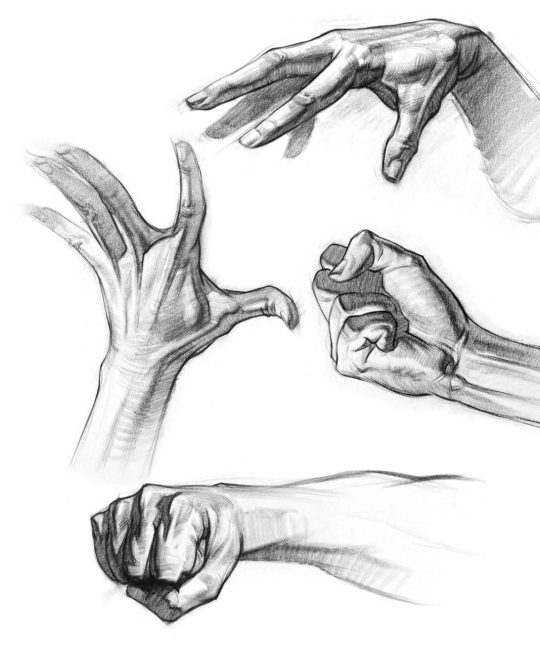
Dibujar la figura:Cabeza, Manos y Pies por Juliette Aristides
Dibujar cabezas, manos y pies a menudo intimida a los artistas principiantes. En este extracto de "Figura Drawing Atelier", Juliette Aristides comparte bocetos que te ayudarán a simplificar el proceso y te inspirarán a practicar.
Copiar y crear parecen conceptos contradictorios. Sin embargo, a lo largo de los siglos, los artistas fueron capaces de dar forma a su propia visión, solo absorbiendo el pasado , por innovadora o personal que fuera, . Egbert Haverkamp-Begemann, Copias creativas

Michael Mentler, "From the Sketchbook", 2007, lavado de tinta, pluma y gouache realzado con blanco, 12 x 9 pulgadas (30.5 x 22.9 cm). Imagen cortesía de Monacelli Press.
Dos Enfoques para el Dibujo
La formación completa de dibujo de figuras se centra en dos enfoques: conceptual (entender conceptos) y observacional (entrenar el ojo).
Un enfoque conceptual se refiere a comprender la estructura, la anatomía y la proporción. Podemos dibujar una figura creíble, en el ideal, sin mirar un modelo, siempre que entendamos la mecánica.
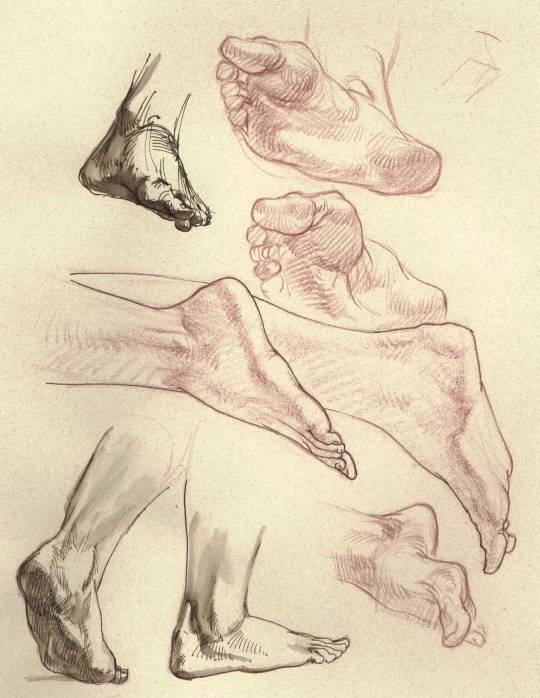
Glen V. Vilppu, "Pies", VilppuAcademy.com. Imagen cortesía de NewMastersAcademy.org y Monacelli Press.
El otro enfoque es el dibujo de observación: dibujar solo lo que ves, no enfocarte en lo que está debajo de la piel sino en lo que hace que esta figura sea diferente a cualquier otra. Este enfoque naturalista entrena los ángulos de la vista para ver, las formas y el valor para dibujar a un individuo, exactamente como es. Tanto la fuerza de la estructura como la sensibilidad de la observación matizada son inseparables cuando uno está creando un buen dibujo.
En principio, un dibujo siempre se aborda como un todo, nunca como una serie de partes; no usamos una fórmula para dibujar diferentes temas. La forma en que dibujamos una cabeza es la misma forma en que nos acercamos a una manzana o una tetera. Sin embargo, puede ser intimidante dibujar ciertas partes del cuerpo, porque son detalladas, complejas y familiares. Solo se necesita un pequeño error para que parezcan equivocados. En este extracto de "Figura Drawing Atelier", veremos principalmente tres partes de la figura que a menudo intimidan a los nuevos artistas (cabezas, manos y pies) y superamos algunos de nuestros miedos simplificando y practicando.
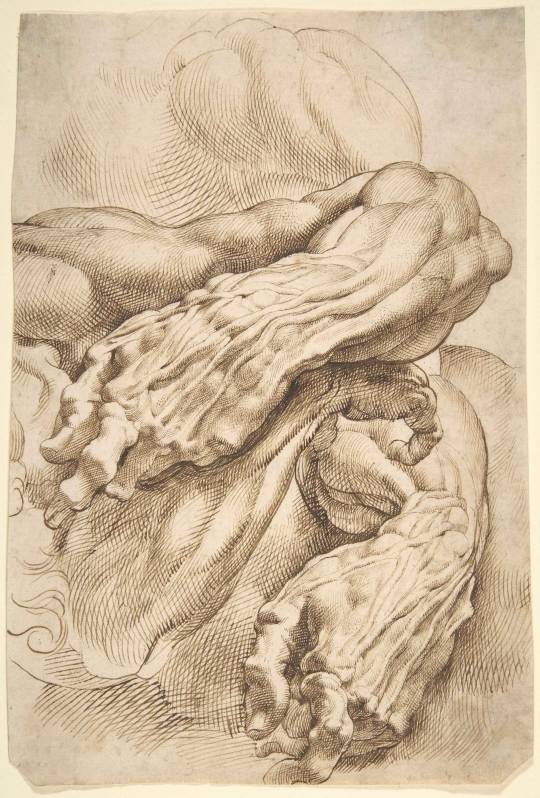
Peter Paul Rubens, "Estudios anatómicos: un antebrazo izquierdo en dos posiciones y un antebrazo derecho", ca. 1600–5, pluma y tinta marrón sobre papel, 10 15⁄16 x 7 5⁄16 pulgadas (27.8 x 18.6 cm), Metropolitan Museum of Art, Nueva York. Imagen cortesía de Monacelli Press.
Click here to view original web page at Drawing the Figure: Heads, Hands, and Feet
Read the full article
#AprenderaDibujar#Dibujar#Dibujo#DibujoArtístico#DibujodeFigura#Dibujodemanos#DibujoparaPrincipiantes
1 note
·
View note
Note
Hey there! Love your artwork so much! What would you recommend to learn/improve in drawing anatomy? Is there a book you recommend or just looking at references? Thanks!
I recommend two books to beginners regarding anatomy/life drawing: “Drawing Manual” by Glen Vilppu and “Figure Drawing: Design and Invention” by Michael Hampton. I especially like Vilppu’s book, as it has a linear structure to it and starts off with extremely simple exercises, making it easy to work your way through chapter-by-chapter.
Both of these books will basically give you the knowledge required to simplify/exaggerate different parts of the body (not just in regards to anatomy but also proportion). As for references, they’re also vital - balancing observational drawing with the stuff you learn from these books will transform your drawing skills (and way of thinking) within a matter of weeks.
-Joel
17 notes
·
View notes
Text
Heppy Father’s Day!
Family time is always lovely. Not much to write about.
So I guess it’s time for drawing notes.
Love love love Michael Hampton’s book on figure drawing. This book is single-handedly saving my drawing skills. This is probably the best primer for figure drawing out there. It is just so clear and easy to understand. Wahh..
Of course I’ve got other teachers to appreciate like Glen Vilppu and Proko to some extent, they’ve all been great resources. But something about figure drawing has never quite clicked until recently with reading Hampton’s book.
I think part of that was due to having a gap in knowledge in how to move from boxy construction figures, to soft organic anatomically correct figures.
His method skips entirely past construction and implicitly combines it with gesture, so that there is no such gap necessary to bridge. Gesture then becomes the construction, and will contain both volume and the proper anatomical build of the figure. No more boxy humans. Well, sort of.
But yeah, right now I’m just doing a whole lot of repeat studies and exercises implementing this method. It’s working out well I’d say, so hopefully I can start building some better figures soon.
0 notes
Video
youtube
Glen Vilppu in figure drawing 1
1 note
·
View note
Video
youtube
Glenn Vilppu Figure Drawing Demo.
Ugh. It's so mesmerizing to watch this guy draw. o___o
7 notes
·
View notes
Photo
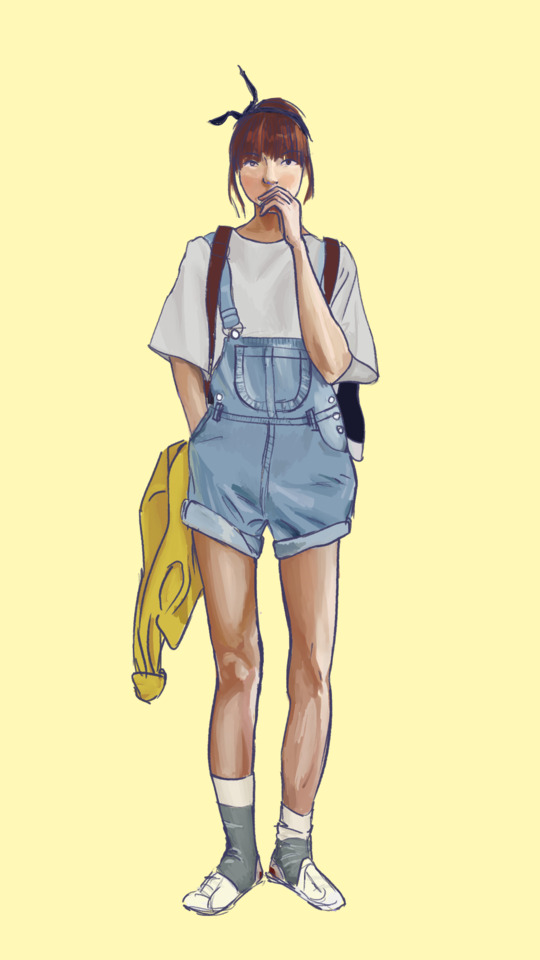

There’s a lot of room for improvement so please show me the way 😄
Extra notes: Aside from the bi-lateral symmetry the body has, each individual limb and body part are asymmetric, you’ll find that the curves from the forms will flow into one another and bounce the eye down it like a river or ski slope.
symmetrical forms will cause a sort of visual collision, that if done unintentionally can disrupt the viewer
Use these 3 types of lines when drawing, you can draw anything with them.
S curves: for stretching, active forms.
C curves: for relaxed and squashed formed
I curves (straights): for rigid masses like bone or other sturdy forms.
you proportioned things quite well, you need to work on your gesture and way of describing forms. Take a look at Glen Vilppu’s The Vilppu Drawing Manual its a excellent place to start when doing figure drawing.
Mod Sy Noon
32 notes
·
View notes